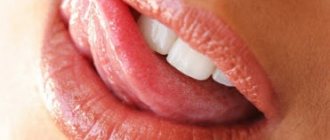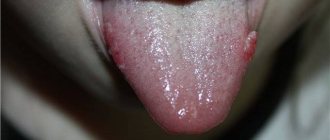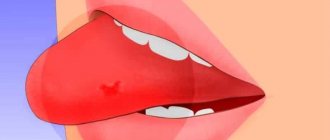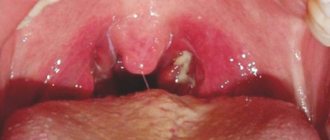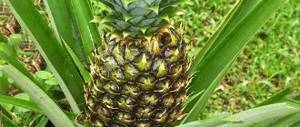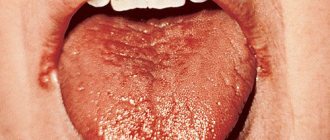Some kind of growth has appeared on the tongue - what is it?
The most common types of growths on the tongue are lipomas, fibroids, papillomas, hemangiomas, and polyps.
| Type of growth | What does it look like |
| Papillomas | Flat - noticeably rise above the epithelium, wide, light in color. They are formed one at a time. Pointed (condylomas) are light-colored neoplasms in the form of papillae with a sharp end. They often merge into groups, grow, and increase in size. Externally similar to the comb or inflorescences of cauliflower. Thread-like - thin, protruding noticeably above the surface of the epithelium, colored bright red. Form groups. |
| Polyps | The neoplasm is flat or convex in shape in the form of a lump, formed from ectopic gastric mucosa. Most often it appears on the root of the tongue. |
| Adenomas | Formed from the glands of the mucous membrane of the tongue, it looks like a small ball. Localized on the tip and root of the tongue. |
| Lipomas | Consist of fat cells. They have a soft, lobed structure, located on the root of the tongue or under it. They grow slowly and do not hurt. Flap lipoma is flat. Can grow deep into tissues. Vulgar - a small bulge on the tongue. |
| Fibroids | Consist of connective tissue. Elastic, painless neoplasms are round in shape and sometimes have a stalk. They do not differ in color from the mucous membrane, sometimes they have a pale yellow or white tint. Neurofibroma contains nerve fibers and is therefore painful. It forms on the root of the tongue and does not differ in appearance from a regular fibroma. |
| Myomas | Growths on the surface of the tongue with a dense structure, up to 1 cm in size, are covered with a mucous membrane. Formed during the proliferation of muscle cells. |
| Hemangiomas | Vascular neoplasms look like red or blue spots. Sometimes they bleed. |
| Cysts | A retention cyst consists of muscle fibers and forms on the inner surface, the frenulum of the tip of the tongue. This is a small ball with liquid inside. |
| Botriomycomoma | The tumor is flat or spherical, reaches 10 cm in size, sometimes consists of several lobules. The shade varies from red to burgundy, the surface is smooth or covered with crusts. |
| Lymphangioma | Congenital benign neoplasm. Grows from the walls of lymphatic vessels. The surface is covered with bubbles, growths are located on the upper surface and tip of the tongue. They often become inflamed and are often accompanied by problems with bite and speech. |
| Struma | It is rare and consists of thyroid tissue cells. This is a small node up to 3 cm in size, formed at the root of the tongue. |
| Sialadenitis | The tumor appears against the background of inflammation of the saliva and sublingual gland. Causes: infectious pathologies, tuberculosis, mumps, syphilis. |
Neoplasms in children and adults are equally common. In adults, these are mainly papillomas, adenomas, cysts, and lipomas.
In a child, papillomas are presented in the form of epithelial hyperplasia - the tissues of the tongue mucosa grow greatly. The active growth of HPV most often begins after influenza, sore throat, or a viral disease. Lymphangioma is diagnosed mainly in children under one year of age. Hemangiomas often occur in girls.
A child sticks out his tongue: why does this happen, how to wean a child from this habit?
From birth, babies strive to communicate with their mother, but their speech is not yet formed until they are 1 year old. To interact, children intuitively use facial expressions and exhibit motor activity in the presence of an adult. Babies use the same means of communication when they feel discomfort or want to communicate their needs.
However, some movements and habits of children may alert parents. So, mothers begin to worry when they observe obsessive thumb sucking or tongue sticking out. Sometimes there really is a reason to worry. To make sure that everything is fine with the baby, parents must understand why the child is sticking out his tongue and what accompanying symptoms should contact a specialist.
Harmless causes of tongue protruding in an infant
In some cases, the reasons for this behavior are obvious. When babies show their tongue at 1-4 months of age, they are most often trying to make their first sounds; the period of humming begins. Children also stick out their tongue in the following cases:
- The child feels hungry. At this moment, the baby reflexively sticks out his tongue, trying to find his mother's breast. With this behavior, he signals his natural needs for food.
- The baby is hot. The baby may show his tongue when he experiences discomfort due to the heat. At this moment he is thirsty, so the reflex is triggered again.
- Training movements. Children tend to explore the world around them and their own body; they touch their legs with their hands, kick, and grab objects. This is how kids train their muscles and learn to control their movements. The tongue has a muscular structure, so it also needs training. Gradually, this body will be actively involved in the communication process.
- The appearance of the first teeth. During the period of eruption of milk units, at the age of 7-10 months, children experience swelling of the gums. The process may be accompanied by pain. This causes inconvenience and discomfort to the child; he tries to get rid of the unpleasant sensations with his tongue, so he periodically sticks it out.
- A game. If a mother, playing with a child, sticks her tongue out at him, then he tries to copy the movement and also diligently shows his tongue.
- Long tongue. In some cases, the baby sticks out his tongue due to its size. Some children have a large tongue that is cramped in their small mouth. With age, the defect smoothes out as the jaw begins to grow.
Dangerous causes of tongue protrusion in children
If the baby's tongue sticks out constantly, parents should consult with their local doctor. A particularly alarming symptom is the tongue falling out of the mouth during sleep.
If during the waking period the baby often opens his mouth, his tongue is not held in the oral cavity, and incessant drooling is observed, then there is a possibility of developing an infectious disease. In addition, similar manifestations occur in infants with pathologies of the endocrine system or suffering from neurological diseases.
Hypothyroidism in a child
A decrease in the functions of the thyroid gland can cause a disease such as hypothyroidism. Most often it occurs due to a lack of iodine in the mother’s body during pregnancy. The consequences for the child can be very serious: with hypothyroidism, there is a lag in intellectual and physical development.
To diagnose the pathology, blood is taken from the heel of newborns in the maternity hospital. If a disease is detected, the mother is invited to consult a specialist. If hypothyroidism was not detected immediately after birth, then it can be determined at 2-3 months of life by the following signs:
- the skin has a marbled tint;
- the child sticks out his tongue, his mouth is open regardless of the need for food;
- the baby lags behind his peers in development;
- the baby's skin is unnaturally dry;
- the child’s tongue swells and does not fit in the oral cavity;
- the nasolabial area has a bluish tint;
- the newborn is not gaining weight well;
- constipation occurs.
Before starting treatment, the baby is carefully examined. They take tests for thyroid hormones and perform an ultrasound of this organ. Next, hormonal therapy is prescribed.
High blood pressure
Another reason that a child’s tongue falls out of the mouth is a neurological pathology resulting from a birth injury.
A characteristic sign of the disease is a thrown back head, an open mouth and a protruding tongue. Also, a child with high intracranial pressure has the following symptoms:
- increase in head size;
- a bulge in the area of the fontanel, which heals very slowly;
- strabismus;
- increased muscle tone;
- tremor of the chin and upper limbs.
The therapy is carried out by a neurologist. If the diagnosis is confirmed, the doctor will prescribe the necessary medications. With appropriate timely treatment, the disease is completely cured.
Facial muscle atrophy
Facial muscle atrophy may also present with uvula protrusion during infancy. The disease occurs due to impaired functionality of the trigeminal nerve. It can be provoked by endocrine pathologies and malfunctions of the autonomic nervous system. In some cases, facial muscle atrophy is a complication of colds or injuries. The main symptoms of the disease include:
- lack of smile;
- inability to use facial expressions;
- swelling of the lips;
- disappearance of folds on the forehead;
- recessed eyelids;
- asymmetry of facial structures;
- deviation of the chin from the center line.
A baby who exhibits such signs must be urgently shown to a therapist or neurologist. Complex therapy is used for treatment, which includes physiotherapy, massage and drug treatment. An example of facial muscle atrophy is shown in the photo.
Some oral diseases
Babies often open their mouths and show their uvula if they have inflammation in the mouth. Among the most common diseases in childhood, pediatricians identify candidiasis and stomatitis.
When there is a fungal infection of the mucous membrane (candidiasis) of the oral cavity, children stick out their tongues, trying to get rid of the discomfort. A one-month-old baby becomes infected with the disease from its mother during feeding or during childbirth.
After birth, candidiasis occurs in two- and three-month-old infants with frequent regurgitation. Dr. Evgeniy Komarovsky is sure: to avoid infection with thrush, the mother must monitor the baby’s hygiene.
Stomatitis can be caused by fungal microorganisms, viruses and bacteria. This pathology is characterized by the formation of small ulcers in the oral cavity, the temperature may rise, and appetite may worsen. Local drugs are used for treatment.
Why does a baby often chew or suck his tongue?
Some mothers note another type of alarming behavior in their children - tongue chewing.
Why does a baby chew or suck his tongue? This usually occurs at the age of 5-6 months, when the moment of eruption of the first milk teeth approaches.
By this time, the child’s salivary glands are already well developed, as preparations are underway for the transition from exclusively dairy nutrition to a mixed diet with the addition of complementary foods to the diet.
Copious secretion of saliva causes a swallowing reflex. The baby learns to swallow excess liquid in the mouth, thus preparing its digestive system for solid foods.
According to pediatricians, a child of this age usually chews his tongue before an upcoming feeding, at times when he feels hungry. However, parents' attention should be drawn to constant chewing of the tongue that is not associated with food intake. According to neurologists, this behavior indicates a high level of nervous excitability.
In some cases, a baby chews his tongue if parents try to wean him from the habit of thumb sucking.
Some mothers strive to wean their babies off the pacifier as quickly as possible, remove all pacifiers, and stop attempts to develop the sucking reflex by the age of 8 months.
Under such circumstances, the child involuntarily tries to compensate for the deficiency, so sucking the pacifier is replaced by chewing the tongue.
Another factor that provokes this behavior is teething. Swollen gums cause discomfort, the baby wants to get rid of the discomfort. He moves his tongue along the gums and in this way tries to scratch the place where a new tooth will soon appear.
Differentiated tongue massage for dysarthria.
For spasticity, a relaxing massage from the root to the tip of the tongue is necessary. In case of pareticity - from tip to root to increase tone.
Hyperkinetic readiness of the tongue (involuntary contraction of the tongue muscles).
For hyperkinesis, tongue massage is contraindicated; the following algorithm is used:
1. Contrasting thermal applications on the tongue (“cold - warm”).
2. Developing retention of the tongue posture through tension - relaxation (“Needle”, “Spatula”; alternating “Needle” - “Spatula”).
3. Formation of articulatory movements. Start with several times, working up to 20 – 30 times.
4. Formation of a chain of articulatory movements.
Decreased tone at the root of the tongue.
If the tip of the tongue is raised upward, but the root is not visible, then this indicates a decrease in tone at the root of the tongue. In this case, the tip of the tongue may be in spasticity. During movement, the root of the tongue is greatly narrowed, everything else is wide and loose. Work on normalizing tone is carried out through movement:
1. Push your tongue forward as much as possible, turn the tip of your tongue down, and place your tongue behind your lower teeth. Make sure that the root of the tongue does not run back into the mouth. Learn to hold a pose.
2. Increasing the tone of the tongue bark outside the oral cavity, then in the mouth (“Watch”, “Shovel”, “Needle”).
Combined violation of tongue tone.
If the tongue is displaced posteriorly, the back and root are tense, and the tip of the tongue is normal, then this is a combined tone disorder (at the root the tone is increased, but at the tip it is normal):
1. Contrast thermal application on the root and back of the tongue (warm - cold - warm).
2. Smoothing the root of the tongue.
3. Learn to move your tongue out of your mouth and into your mouth along the midline.
We invite you to familiarize yourself with Ketanov - instructions for using tablets and injections, price, analogues
4. Learn to control the tone of the tongue (“Watch”, “Tongue forward - in the cheek”, “Spatula” - “Needle”, “Slide” - “Slide has melted”).
The combined tone can be expressed in spasticity of the root and pareticity of the tip:
1. Local thermal applications (on the root and back warm-cold - warm, on the tip cold - warm-cold).
2. Toning finger massage of the tip of the tongue.
3. Smoothing the root of the tongue.
4. Alternating exercises for tension - relaxation of the tongue.
Classification of speech disorders Speech and speech disorders are studied by many sciences: medicine, psychology, pedagogy, linguistics, psycholinguistics, etc. Each of them is considered.
A child chews his tongue at 3 months and older: why and how to wean him from this habit?
Often, young parents are faced with a wide variety of problems that arise with their child. Bad habits are common in young children. They can harm the baby himself, or their harmful effects will affect them years later. Besides, it's not pretty. Among the many habits, the most common are chewing and tongue sucking.
Why does a baby chew and suck its tongue?
You should not panic if you notice this, but you should figure out the reasons and eliminate the “bad habit” in your child yourself or seek the help of a doctor. There are many factors in the development of this phenomenon, and in this article we will try to identify possible sources of the problem and find ways to solve them.
Possible diseases
Sometimes the cause of chewing and tongue sucking can be various pathologies:
- The so-called thrush (an infectious fungal disease that affects the baby’s oral mucosa) is a common problem that parents face. Due to the whitish coating on the cheeks, gums, and especially the tongue, the child can stick it out, chew and suck. In addition to dense deposits, the child may feel pain and discomfort. To identify and treat the disease, you need to consult a pediatrician.
- If a child chews his tongue, endocrine diseases may be the cause. Hypothyroidism - insufficient production of thyroid hormones - can also manifest itself in the muscular organ. It swells and becomes larger than normal. The child tries to “remove” it from his mouth, that is, he walks with his tongue sticking out. It is clear that discomfort can also result from chewing the tongue. Endocrinologists identify this pathology and prescribe treatment.
- Pathologies of the jaw bones and malocclusion are phenomena that cause children of several months of age to chew and suck their tongue. Due to an excessively small lower jaw and irregularly shaped dental arch, children can feel the “size” of the tongue and, as a result, pay attention to it and chew it.
- This can also apply to children during the teething period - when the gums become inflamed, itchy and painful. To reduce discomfort, the child tries to compensate for the pain by chewing his tongue. During teething, you need to visit a pediatric dentist, and for children with existing teeth and pathology of the bite or jaws, an orthodontist.
- The reason for chewing and sticking out the tongue during sleep is increased intracranial pressure. Children with such problems should be urgently shown to a pediatrician.
READ ALSO: Why does a baby sometimes stick out his tongue?
If a child adheres to this habit for a long time, and there are no other symptoms, then he should consult a neurologist. He will help you find the problem and fix it.
Causes not related to pathologies
The most common cause of tongue chewing in infants is the child's transition to feeding adult food. Before the baby begins to eat food containing solid elements, it develops increased salivation.
This process appears at 3-4 months and older. The mechanism of the phenomenon is simple - for the normal absorption of such food, saliva mechanically helps its passage from the oral cavity further along the gastrointestinal tract.
It performs an important function - it breaks down carbohydrates using the enzymes it contains.
In this regard, excessive salivation often forces the baby to move his tongue in the mouth, chew and suck it.
READ IN DETAIL: increased salivation in infants: causes and solutions
The reason could also be simple hunger. When feeding time comes, the baby begins to chew his tongue if he does not get food. However, over time, when the child learns to express his need for food and immediately receive it, the bad habit will stop.
During the developmental period of the baby, while he is weaned from the pacifier, he may chew and suck his tongue due to habit. Accustomed to constantly having a pacifier in the mouth, the child, in its absence, feels that something is wrong, and automatically makes chewing movements coupled with sucking - only now these actions extend directly to the tongue.
When the baby is busy with an interesting game, watching cartoons or communicating with people and pets, he may chew and suck his tongue or even stick it out. There is nothing wrong with this and, most likely, he is simply busy with an interesting activity, and, as you know, even adults who are carried away by any process can perform uncontrolled actions.
As a bad habit, tongue chewing can develop in children older than 12 months. This is one of the common habits (along with thumb sucking and nail biting) that children develop when they are bored. Without proper attention from adults, the baby begins to amuse himself, and this will lead to such actions as systematic chewing and tongue sucking.
Associated symptoms
Many symptoms of various diseases can accompany tongue chewing. As mentioned above, these are endocrine disorders, infectious diseases, often teething or pathologies of the bite and development of the jaw bones.
In addition to all of the above, this habit can be accompanied by many inflammatory diseases of the oral cavity:
- glossitis - inflammation of the tongue,
- stomatitis - inflammation of the mucous membrane,
- gingivitis – inflammation of the gums.
These pathologies always cause discomfort in babies in the form of itching and pain, so they begin to drown it out by chewing their tongue. A vicious circle is created here - the child bites the tongue, thereby injuring it, which further aggravates the inflammatory process. That is why chewing the tongue itself contributes to the development of diseases.
Three month old baby
The answer to the question “why does the baby bite and suck his tongue” has been received. Now we’ll answer how to wean your baby from this habit.
First of all, you need to distract the child. If the baby is three months old or more, then you can give him a pacifier. It is recommended to buy rubber toys for children during the teething period. The same applies to tongue sucking - instead, give the child a pacifier or toy, wean him off the habit with the help of a distracting conversation, song, or poem.
After 3 months of age, do not swaddle your baby with your hands. During this period of development, children learn about the world around them and themselves - exploring and “tasting” their hands and fingers is natural. If you do not give your child this opportunity, it is quite possible that he will develop the harmful habit of chewing his tongue.
Older child
Children after 1 year should absolutely not be given a pacifier - teeth that have already erupted in the period from 5 to 6 months will experience excess pressure, which will lead to bite pathology.
A wonderful alternative to a pacifier can be your baby's favorite toy.
Don’t forget also about the special rubber rings that are given to babies during teething – the child will switch to them and stop chewing his tongue.
If the child already understands speech, explain that his manner of chewing his tongue is a harmful activity that leads to the development of inflammatory diseases, and, finally, that a child chewing his tongue is ugly and disrespectful to the people around him. Pay attention to your child more often, watch his facial expressions and gestures, do not neglect the recommendations of pediatricians and pediatric dentists, and your baby will not allow such actions as chewing and tongue sucking.
Loading…
Source: https://spacream.ru/stomatologiya/pochemu-rebenok-v-vozraste-3-mesyaczev-i-starshe-zhuet-yazyk-kak-otuchit-ego-eto-delat
Treatment of candidiasis
Externally, the oral mucosa is treated with a solution of borax in glycerin at a 10% concentration. You should also rinse your mouth with chamomile decoction, soda solution and irrigate the mucous membrane with 2% boric acid. Tablets for oral administration with antifungal effect:
- Nystatin is a rather old, but proven and effective remedy for Candida fungus, tablets with a dosage of 250-500 thousand units. taken 3–4 times a day, it is not recommended to crush or chew them beforehand; the course of treatment is 10–14 days.
- Lamisil - tablets that need to be taken one per day (active substance content 250 mg), the course of therapy depends on the depth of damage to the epithelial layers and the duration of the disease.
- Terbinafine is a fungicidal agent, which will take from a week to 1-2 two months to be treated, take one tablet once a day with a dosage of 250 mg.
It must be remembered that candidal glossitis often accompanies long-term infectious diseases, for which the patient uses large doses of antibiotics. Sometimes it is enough to cancel antibacterial agents and apply external treatment to the tongue several times so that the symptoms of glossitis go away on their own.
Reasons for appearance
Growths on the tongue appear against the background of dental diseases, dysfunction of internal organs, or due to non-compliance with hygiene rules. One of the main causes is the human papillomavirus (HPV). When it is activated, papillomas are formed. The risk group includes people with autoimmune pathologies and immunodeficiency conditions, people who are promiscuous.
Provoking factors:
- taking certain corticosteroids;
- stomatitis, glossitis, periodontitis, systematic injuries of the tongue and oral mucosa;
- indulging in hot or spicy foods leads to burns on the mucous membrane, which are poorly treated in a constantly humid environment;
- candidiasis, herpes;
- intestinal infections, helminthic infestations, metabolic disorders;
- frequent stress;
- smoking, alcohol abuse, working in hazardous industries;
- avitaminosis;
- changes in hormonal levels during pregnancy, menopause, and puberty;
- In children, papillomas appear due to the habit of putting dirty hands and objects into their mouths;
- contact with a sick person or carrier of infection.
In older people, growths on the tongue occur due to age-related changes in the body and improper care of dentures.
Congenital growths in children appear due to poor heredity, intrauterine development disorders, viral diseases of the mother during pregnancy, and birth injuries.
Why does an infant suck his tongue?
Pediatricians name several reasons for this behavior of the baby, and, as a rule, they combine a whole range of manifestations - sucking of the tongue, finger, lips, tissues (corner of a pillow, blanket, clothes, etc.). All of them are associated with an unsatisfied basic sucking reflex of a small child. Experts note that this behavior is more typical for bottle-fed infants and those who are fed strictly according to the clock.
- The child is hungry
- The baby lacks sucking movements (the mother rarely gives the breast or bottle)
- Babies who are not allowed to suck their thumbs (they swaddle their hands, put on “scratchies”) can suck their tongue.
- A child who does not feel safe may suck his tongue (and other inappropriate objects). This behavior can become entrenched on a subconscious level and remain for a long time as a bad habit.
In most cases, the habit of tongue sucking goes away without consequences on its own by 7-9 months. But sometimes in this way the baby helps himself cope with the discomfort during the eruption of his first teeth.
Source: Freepik
Comprehensive correction program for dysarthria
Olga TrifonovaComprehensive correctional treatment program for dysarthria
Dysarthria is a disorder of breathing, sound pronunciation, and voice production caused by a violation of the innervation of the speech apparatus.
For dysarthria, a comprehensive medical, psychological and speech therapy approach is required.
1. Medical impact.
The accompanying note to the neurologist and speech therapist should describe:
— tone of the facial muscles (jaw, cheeks, lips, forehead, nasolabial folds);
— facial expressions (are there any synkinesis (concomitant movements of other muscles);
- tongue with a half-open mouth (is the tip pronounced, deviation, tremor, restlessness, cyanosis, salivation);
— presence of MMD, MSD signs (underdevelopment of mental processes);
— presence of signs of hypertension syndrome (hyperdynamia).
pharmacotherapy - the following drugs are used in combination for rehabilitation treatment:
- neurometabolic cerebroprotectors - drugs that improve metabolism (metabolic processes in nerve tissues) - produce energy in nerve cells, enrich them with vitamins, protect the brain from the effects of hypoxia, help reduce the clinical manifestation of minimal cerebral dysfunction (MCD) and restore higher cortical functions, reduce intellectual and mnestic disorders, normalizes the autonomic function of the neurological status, improves metabolism (Cerebrolysin, Nootropin, Cortexin, Piracetam, Pantogam, Actovegin, Phezam);
— angioprotection — drugs that improve cerebral circulation (Fezam);
- dehydration, brain washing process - drugs that force increased blood circulation (Asparkam K, Orotate K);
— hepatoprotection — drugs to improve liver function and phospholipid metabolism (Essentiale, Gepatrin);
— mineral and vitamin complex (Biovital, Vitamin B);
- anticonvulsant correction (with an increased threshold of convulsive readiness - drugs that prevent stuttering and epilepsy);
- diuretics (dehydration) - to reduce intracranial pressure (hypertension) - remove excess fluid, normalize hyperdynamia, especially in the evening.
We invite you to familiarize yourself with Removable dentures: installation, care, types
Potassium (potassium orotate) must be taken along with diuretics;
- behavior correctors - anticonvulsant and resolving medications.
Absorbable - in order to reduce the growth of fibrous, scar tissue, which immurs nerve cells and fibers (for cytoplasmosis - Lidaza, Aloe).
Anticonvulsants - for stuttering and episyndrome (Phenibut, Pantogam can increase seizures).
Antipsychotic drugs that regulate emotional and behavioral reactions (Rispolept).
2. Psychological impact.
Development of mental functions:
A) formation of working capacity (frequent change of activities, gymnastics for the neck, physical exercises);
B) development of thinking, memory, attention, imagination.
A decrease or disorder in performance, attention, memory, perception indicates the presence of MMD, MSD.
3. Speech therapy intervention:
A) normalization or improvement of muscle tone:
— articulatory gymnastics (involuntary, voluntary);
B) development of phonemic hearing and perception; process of analysis and synthesis;
C) work on physiological, speech breathing; voice; prosody.
D) production of sounds;
D) automation of sounds.
3. Speech therapy for dysarthria.
Normalization of muscle tone.
Tongue hypertonicity is increased, overly tense muscle tone.
80% of interdental pronunciation is spasticity (involuntary contraction due to disruption of the conduction of nerve impulses due to spinal cord or brain injury) of the back and root of the tongue.
1. Work on normalizing the tone of the tongue in static conditions.
First, we ask the child to extend his tongue forward and determine the range of tongue removal and tone. If the tongue is compressed at the edges like a “sausage,” then the tongue is in complete spasticity, i.e., in hypertonicity.
Correction: - drug treatment, electrophoresis with antispasmodics on the collar area;
— thermal application with heat on the cervical-collar area and tongue through the use of warm liquid (warm gauze compress);
— relaxing massage on the cervical-collar area and tongue (smoothing movements from the root to the tip of the tongue with a frame probe without mechanical fixation of the tip).
2. Work to normalize the tone of the tongue in dynamics:
- spreading the tongue using articulatory gymnastics
- hold your tongue relaxed for up to 30 seconds. outside the mouth;
— increasing the tone of the tongue (“Needle”);
- differentiation of tone (“Needle” - “Pancake”) with open and closed eyes;
- relaxation and tension of the tongue in the oral cavity.
Tongue hypotonia is muscle weakness, the inability to hold muscles in a certain position for a long time.
If the tongue is wide, when pressed with the teeth, imprints remain - this is pronounced pareticism (weakening of voluntary movements caused by damage to the motor centers of the spinal cord and/or brain).
1. Work on normalizing the tone of the tongue in static conditions.
— toning massage on the neck-collar area (cold compress for up to 1 minute);
— cold thermal application on the tongue (a piece of ice on the entire surface of the tongue for up to 20 seconds, 3 – 5 approaches);
- tonic manual massage of the tongue or using probes from tip to root;
2. Work to normalize the tone of the tongue in dynamics:
— improvement of tone through movement (“Squirrel”).
- maintaining tone through movement (“Clock” with intermediate movement along the midline);
- differentiation of tone (“Spatula” - “Needle”);
— formation of the correct articulatory structure.
Articulation gymnastics for dysarthria.
It is carried out in parallel with the normalization of the tone of the tongue.
1. Licking the plate without using your hands 5 – 7 times a day. Start with droplets the width of your tongue.
2. Chewing gymnastics. Chew carrots, cucumbers cut into strips, and a crust of bread with your chewing teeth.
3. Work on normalizing and differentiating tone using traditional articulatory gymnastics exercises.
4. Formation of correct articulatory structure.
With dysarthria, deviation (deviation) of the tongue in the plane may be observed.
In dynamics, the tongue deviates away from the midline (to the strong side, and not to the healthy or sick side).
If in the mouth, if the tongue is shifted to the side and pulled back, then this is spasticity. If the tongue curls on its edge, then this is pareticism.
1. Work on articulatory movements:
— we bring the tongue forward and send it in the opposite direction from the deviation to the corner of the mouth (mechanically) and return it to the midline again. We do this until the deflection angle decreases;
- remove the tongue from the mouth and move it 2-3 times in the direction opposite to the deviation, returning it to the midline; 1 time in the direction of deviation with a return to the center line;
— “Clock” exercise with a return to the midline;
- exercises for differentiation of tone: “Scapula” - “Needle” outside the mouth; “Gorka” - “The slide melted” in the mouth.
2. Formation of correct articulatory structure.
We suggest that you familiarize yourself with Tablets for bad breath
Gymnastics for the neck.
Goal: - normalization of blood outflow from the brain (normalization of intracranial pressure);
— prevention of cervical osteochondrosis.
1. Look at the shoulder - behind the back - at the shoulder - behind the back.
2. Draw a circle in front of you with your chin.
3. Press your head into your neck (“spring”).
4. Make a circle with your head to the right, left.
5. Perform a circle with your shoulders: up - back; up - forward.
6. “Bicycle” - circle with two shoulders forward; two shoulders back; one forward and the other backward.
Contrastothermometry.
Contrast thermometry is used on the face, neck, and tongue.
Purpose: - impact on muscle contractility at the reflex level through temperature differences to normalize tone.
Cover the face from the scalp to the neck with 4-6 layers of gauze with a hole made for the nose. Place cellophane and a blanket on top.
Alternate hot and cold masks. The higher the contrast, the greater the effect. Course – 21 days.
With spasticity: cold - heat (x - t);
With pareticity - heat - cold (t - x).
In severe cases, repeat the face masks after 21 days until the effect is achieved.
For spasticity: (x – t – x – t – x – t) (t – t – t).
When paretic: (x – t – x – t – x – t) (x – x – x).
Why does a baby constantly chew, show or stick out its tongue?
Sometimes parents may notice that the child's tongue falls out of the mouth area.
If such signs are present or the baby does not put the tongue back for a long time, then you should contact a specialist. Below in the table we will look at what diseases can be accompanied by protruding tongue. Diseases that can cause your baby to stick out his tongue
| A disease that causes the baby to stick out his tongue | Associated symptoms of the disease | Which doctor should I consult? | What examinations, tests and treatments can the doctor recommend? |
| Hypothyroidism | Hypothyroidism reduces thyroid function. With this disease, the baby's tongue falls out of his mouth. The disease is also accompanied by severe weight gain or jaundice. | Consultation with an endocrinologist is necessary. | For this disease, a wide range of examinations are carried out: ultrasound, urine, etc. |
| Facial muscle atrophy | With atrophy of the facial muscles, the baby not only sticks out his tongue, but also cannot control the facial muscles (does not smile, does not grimace) | In this case, the pediatrician may recommend contacting a neurologist. | To diagnose this disease, an MRI or CT scan is performed. Treatment is medicinal. Massage may also be recommended. |
| Thrush (candidiasis) | Often you can see white on the baby's cheeks and palate. | If you see a strange plaque in your baby's mouth, you should contact your pediatrician. | Oral swab for fungus (candida). |
| Stomatitis | With this disease, you can notice small ulcers in the oral cavity, which cause the baby to stick out his tongue due to discomfort, because ulcers can also affect the lower part of the tongue. | In this case, it is worth contacting a pediatrician, who, if the disease is advanced, will refer you for a consultation to a pediatric dentist, immunologist or infectious disease specialist. | In case of stomatitis, the baby’s oral cavity is examined. The doctor may want to take a smear to rule out other oral diseases. Stomatitis is treated with medication. Parents also need to treat the baby’s mouth with special decoctions or ointments to eliminate the disease. |
| Intracranial pressure (ICP) | If the baby sticks out his tongue, throwing his head back, then this is a clear sign of ICP. This symptom can even occur during sleep. | A consultation with a neurologist is required, who, if the diagnosis is confirmed, will prescribe medication and massage. | To determine this disease, an ultrasound examination (ultrasound) is performed. |
| Tongue hypotonia | The baby's tongue is protruding and loose. Also sedentary. It usually occurs in premature babies, as well as in those who have problems with the endocrine system. | The examination requires consultation with a pediatrician and neurologist. | The baby must undergo an ultrasound, after which drug therapy and physical therapy are prescribed. Water procedures are often prescribed, since with hypotension the baby has trouble holding his head up and sitting. |
The nervous system of children 3-5 years old is not yet particularly developed, so many children, when doing something exciting, may unconsciously stick out their tongue. When they concentrate their attention on any object (assembling a puzzle, constructor, drawing, etc.), the brain cannot yet keep track of all the processes, but this moment is the norm at this age. Over time, the baby will learn to control his body perfectly, and such situations will no longer occur.
Typically, children 3-5 years old stick out their tongue when:
- They are doing something diligently. If the baby is serious about doing something (draw a picture, build a house from parts, etc.), then concentrating his attention on monotonous, painstaking work, he can stick out his tongue.
- They can't do anything. If a child fails to do something the first time (color a picture, read a syllable, a letter), due to this overstrain the brain does not follow all the processes.
- There are problems with speech. In this case, when talking to the baby, you can see how he sticks out his tongue, trying to tell something. A speech therapist deals with this problem.
- They are capricious or show character. In this case, you need to stop the child and not allow him to make such gestures, even if they come involuntarily.
If there are no pathologies or diseases, then the problem of a protruding tongue “dissolves” by itself over time as the baby grows up.
This happened to us. If I tried to force him to chew and swallow, then it was to the point of vomiting %) . In short, I gave up on it and decided to just wait it out. If a baby has a habit of chewing his tongue, then it is better to accustom the baby to a pacifier, which over time he will be able to refuse on his own. It is important to focus the child’s attention on the fact that chewing his tongue looks ugly, that it is impossible to do this, and that if he continues to chew his tongue, everyone around him will laugh at him.
Some children begin to chew their tongue when they feel lonely or bored, and this is more true for babies one year old and older.
I don’t know, my 4-year-old niece still doesn’t chew properly, but immediately swallows.
Moreover, bread, sweets, cookies, bananas - no problem.
He doesn't chew either. Choking.
Surely it should get boring?
It seems that I don’t see any other neurological symptoms (the beard doesn’t shake, the hands don’t tremble). Constant problems with the gastrointestinal tract, constipation. If you grind a larger soup in a blender, you’ll get a gag reflex.
Then, when I gave birth to her, or rather, when they took her out of my stomach (caesarean) and then showed her to me, she also stuck out her tongue. And the next time he starts doing his own thing, don’t focus on this habit of his and don’t scold him, but simply distract him by switching his attention to something interesting. Pay attention to the situations in which the child sucks his tongue - before bed, when he is nervous, when he is relaxed, etc. Children of preschool and school age often stick out their tongues with zeal when they are very busy with something or are very focused on something.
Think about whether your baby is receiving enough attention and affection. Perhaps it is worth spending more time with him, distracting him with various interesting games, books, toys.
With age, the child sucks his tongue less and less, and then completely gives up this habit, but it also happens that he does not give up, and continues to do it even at school age.
By the way, a protruding tongue is not always a symptom of something; perhaps the child simply has a small mouth, and the tongue has grown faster and does not fit in the mouth.
A child’s bad habit of chewing his own tongue can be caused by a variety of reasons that vary depending on the age characteristics of the small household.
It is the lack of attention from adults that very often becomes the reason for a child to develop such bad habits as tongue chewing, nose picking, and nail biting.
Every caring parent watches the development of their baby with trepidation and, if any suspicious symptoms are detected, they immediately begin to sound the alarm, sometimes even without reason.
My sister didn’t throw away the blender in time.
Give it to kindergarten, everything will work out.
A newborn baby requires close attention from parents. At this period of his life, a lot of things happen that are incomprehensible to mom and dad. One of these oddities may be a tongue that often sticks out. Why does a 4-5 month old baby stick out his tongue? There are many excuses to explain this phenomenon.
When you see your baby making such a gesture, pay attention to his state of health. It is very important to know how your baby sleeps. What position does his head occupy? Do grimaces appear on his face? Observing this period of life is very important. It will help to recognize the disease, a symptom of which this gesture may be.
Reasons why a 4 month old baby sticks out his tongue:
- Another reason will be the size of the tongue. It can be big and doesn’t fit in your mouth. Therefore, you need to go to the doctor. Perhaps there is a discrepancy with the norm;
- A disease can also be considered the cause of a protruding tongue. If it is identified earlier, it will be eliminated more successfully;
- The baby may be teething. Gums itch. To relieve this symptom, a 4 month old baby sticks out his tongue. He gives a light massage, relieving pain;
- the child will show his tongue when feeling thirsty or hungry. This habit is especially obvious in children who are bottle-fed. This gesture will mean a desire for contact with mom. It is with his tongue that he works, sucking milk from the bottle;
- the baby may show his tongue when he is hot;
- when mom is not around. He doesn't cry, he bites his tongue in anticipation;
- in the presence of thrush. Experiencing discomfort from the white spots, he involuntarily performs this gesture;
- for stomatitis. This disease is accompanied by discomfort and pain. The baby tries to show his mother where it hurts, thus talking about his suffering;
- The reason for the appearance of the tongue is high intracranial pressure. The baby will throw back his head while sleeping. A doctor's help is simply necessary;
- When your tongue falls out, you should immediately go to the doctor. The cause is a problem with the thyroid gland, atrophy of the facial muscles.
If a child grimaces and plays, the frequency of his actions is important. If a child sticks out his tongue at 4 months only during playtime, there is nothing to worry about. This phenomenon is normal and quite common. He simply experiences pleasure, joy, any positive emotions. Quite often, in this way, the baby tries to make a sound.
Often these actions can be seen during the game. When a child gets carried away, he does everything involuntarily. He expresses emotions. This gesture may be accompanied by puffing and groaning. This reaction is considered natural to everything that happens around him. A 4-month-old baby sticks out his tongue, getting to know the world around him.
The first tooth may appear before six months. The gums begin to itch. A 4-month-old child constantly sticks out his tongue, performing massage actions, relieving pain. There is no need to worry here.
While in the crib, the baby raises and lowers his legs, waves his arms, and tries to roll over. For him, this is a kind of exercise. Moving the tongue can also be considered as one of the exercises.
Other drugs
In addition to treatment with the listed agents, therapy for glossitis involves the intake and use of other drugs, depending on the clinical need:
- antihistamines - for the allergic nature of the disease, these are Claritin, Zyrtec, Loratadine, Suprastin, Diphenhydramine;
- hormonal - in severe forms of the disease, accompanied by shortness of breath and severe swelling of the throat mucosa, these are Prednisolone and Hydrocortisone;
- antiviral - Interferon, Cycloferon, Viferon, used for the viral nature of the disease;
- immunomodulators - necessary in cases where glossitis acquires a chronic etiology and manifests itself in relapses against the background of a sharp decrease in immunity, these are Immunal, Bronchomunal, Echinacea tincture;
- healing agents – rosehip and sea buckthorn oil, vitamin A;
- vitamin complexes – are prescribed in almost all cases of glossitis; it is especially necessary to replenish the body’s reserves of B vitamins and iron (with concomitant anemia).
In the form of applications that are applied to the tongue, the drugs Lidocaine in 2% concentration, Trimecaine in 2% concentration and Novocaine are used. These substances are part of many anesthetic gels, which are necessary for patients with glossitis, because most often the disease causes acute pain. It must be remembered that successful treatment of glossitis involves complex therapy, depending on the root cause of the disease.
If the pathology develops simultaneously with dysbiosis, treatment is carried out by a gastroenterologist. Blood diseases, and at the same time signs of glossitis, are the prerogative of a hematologist. And so on, depending on the factor that provoked the inflammatory process in the cavity of the tongue. Self-medication and ignoring the symptoms of the disease are strongly discouraged, since poorly treated glossitis can be complicated by phlegmon, abscess and even blood poisoning.
Physiological reasons
- A child may suck his tongue because it has begun to grow a little faster than his mouth and is a little bothersome to him. There is no need to be afraid of this situation - everything will soon return to normal, it’s just how the child grows.
- The child may be teething, and he is trying to get rid of unpleasant sensations. A good remedy in this case would be a pacifier or a special teether. You can put it in the refrigerator before giving it to your child. When cooled, the teether will not only wean the baby from tongue sucking, but also relieve pain in the gums. Gradually, with the appearance of the first teeth, the child’s attention will be diverted to them. He will touch his first teeth, feel them with his tongue, and soon he may completely forget about sucking.
The most effective drugs
Drug treatment of glossitis involves the use of such common drugs as Vinizol, Chlorhexidine and Solcoseryl. Each of these drugs has its own functions, but their combined use can increase the effectiveness of symptomatic treatment of glossitis. Vinisol is widely used in the treatment of burned surfaces, ulcerative lesions that do not heal for a long time, as well as for the speedy restoration and healing of tissue.
The release form of the drug is a spray, the composition includes the components vinylin, propellant, citral and linethol, and the product itself has powerful anti-inflammatory and wound-healing properties. The drug must be sprayed onto the inflamed surface of the tongue 1-2 times a day, the duration of spraying is several seconds.
The next product is Solcoseryl, a gel for healing and rapid tissue regeneration. Its beneficial properties:
- heals damaged mucous membranes;
- improves metabolism in epithelial cells;
- improves the supply of tissues with oxygen and nutrients;
- increases the amount of collagen fibers produced;
- stimulates cell renewal.
In addition to the listed properties, Solcoseryl gel creates a thin film on the surface of the mucous epithelium that prevents infectious agents from entering the layers of damaged tissue. Before using the drug, it is also necessary to clean the surface of plaque. Treatment with the gel is carried out three times a day until a positive effect is obtained in the form of drying of ulcers and healing of cracks in the tongue.
The drug affects a wide range of gram-positive and gram-negative microbes, but is powerless against fungal infections. Cases of an allergic reaction to Chlorhexidine are extremely rare; the product should be used three times a day; it is also suitable for lubricating the mucous membranes and irrigating.


